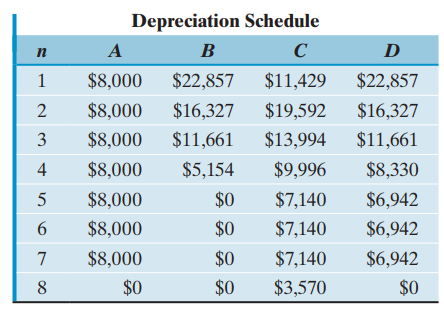Consider the data in the following two tables: First cost¦¦¦¦¦¦¦¦¦¦¦¦¦¦..$80000 Book depreciation life¦¦¦¦¦¦¦¦¦.7 years MACRS property class¦¦¦¦¦¦¦¦....7
Question:
First cost€¦€¦€¦€¦€¦€¦€¦€¦€¦€¦€¦€¦€¦€¦..$80000
Book depreciation life€¦€¦€¦€¦€¦€¦€¦€¦€¦.7 years
MACRS property class€¦€¦€¦€¦€¦€¦€¦€¦....7 years
Salvage value€¦€¦€¦€¦€¦€¦€¦€¦€¦€¦.€¦€¦..$24000

Identify the depreciation method used for each depreciation schedule as one of the following:
(a) Double€declining€balance depreciation
(b) Straight€line depreciation
(c) DDB with conversion to straight€line depreciation, assuming a zero Salvage value
(d) MACRS seven€year depreciation with the half€year convention
(e) Double€declining€balance (with conversion to straight€line depreciation)
Salvage value is the estimated book value of an asset after depreciation is complete, based on what a company expects to receive in exchange for the asset at the end of its useful life. As such, an asset’s estimated salvage value is an important...
Fantastic news! We've Found the answer you've been seeking!
Step by Step Answer:
Related Book For 

Question Posted:





